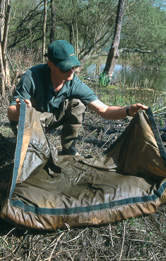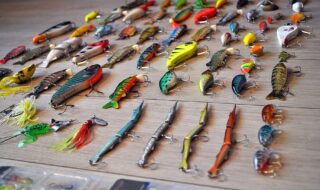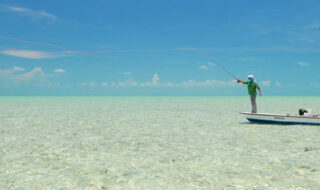Simon Scott gives his views and advice on the essential issue of carp care. How can you best look after the carp you catch?
IT’S vital for the future of our sport that we look after the fish we catch and the environment it lives in. In a day and age when angling is being put increasingly under the spotlight in the media, the more we can do to promote the fact we do genuinely care for the waterside environment, the wildlife that lives in it and the fish we catch, the better.
We decided to be a bit different in this month’s instalment of ‘Improve Your Carp Fishing’ and interview Simon Scott about his opinions on the issue of carp care.
Simon is probably one of the best people to speak to about this. An expert on fishery management and fish biology (he lectures on the subjects at Sparsholt College), few people are better qualified to give an authoritative view on what’s best for the carp after it has been hooked than Simon.
So, here we go…
The Interview
TC: Simon, the issue of carp care is probably something that isn’t covered in enough depth by any current carp publication. Hopefully, through this article, you can educate newcomers to the sport and the more experienced anglers as to how they should be looking after the fish they catch.
SS: I hope so! The whole theme of carp care covers several different issues. Perhaps the most obvious is the welfare of carp while they’re on the bank. People should remember that carp are helpless out of water and are completely in the hands of the successful angler. Should that person not be capable of looking after a fish, its safety could be in jeopardy.
One of the most important items of kit any carp angler could possess is an unhooking mat. I use two different mats regularly, depending on where I’m fishing and the size of fish I’m likely to catch.
For instance, when fishing for big carp at somewhere like Wraysbury, I prefer to use the Cotswold Aquarius Deluxe mat. It’s very big, extremely well padded and very comfy for me to lie on! In fact, I’ve fallen asleep on it before now!
Inside the mat is a generous layer of foam along with plenty of poly balls. The inclusion of the poly balls is important – you can use them to form a depression in which you place your carp. Then, if the fish flaps, the surrounding poly balls absorb the fish’s lunges, making it difficult for the carp to get off the ground or slide off the mat. The Cotswold mat is by far the best mat I’ve seen on the market.
However, I also use a smaller (but still amply padded) Wychwood mat when I’m fishing for smaller fish.
TC: Isn’t that compromising the fish? Just because they’re smaller doesn’t mean they don’t deserve the same degree of protection.
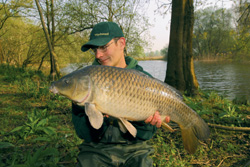 |
| This common has been caught a few times in its life yet, because it’s been looked after, it is still in pristine condition |
SS: I agree. The Wychwood mat is very good and decrease in size is relative, so the fish is still getting the same levels of protection from it.
The important thing to point out here is that mats are essential bits of kit, even for juniors and beginners. If you haven’t got much money, just buy what you can afford, because any mat is better than no mat. These days, even £10 buys you a reasonable unhooking mat that can help protect the fish’s flanks coming into contact with hard ground and sharp stones.
Mats are essential because they help protect the layer of mucus you can find over the carp’s skin. They also help protect scales, ensuring that, as the carp get bigger and older they stay in prime condition. No-one wants to catch fish with tatty fins and missing tails, which could happen if you unhooked fish without a mat.
Mats are also important as they help tell the public that we are serious about looking after the carp we catch and the environment they live in.
TC: Is wetting your mat before putting a fish on it important?
SS: Yes, very much so. Before you place a recently-caught carp on any unhooking mat, please make sure that the mat is covered in fresh, cool water. This is particularly important in the height of summer. Mats left in the sun can get very hot and a carp placed on a hot mat could be damaged. So make sure you wet them before using them.
TC: Another issue when it comes to protecting carp’s flanks and fins is landing net mesh. Do you think that the type of mesh you find on landing nets is important? If so, what type of mesh is best?
SS: It is important. I’m not a fan of nets with large diameter meshes, no matter where on the net that large mesh is to be found.
I much prefer nets that are made from soft micromesh, or smaller. Sure, they are harder for the angler to handle than nets with big meshes, but what’s more important? Your comfort or the fish’s safety.
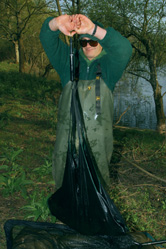 |
| Never lift your fish high off the ground… Then, if you accidentally drop it onto the mat, no harm will be done |
On nets with large meshes, fins can stick out between the mesh and get torn. Also, leads can drop through the mesh rather than fall straight to the bottom of the net where the carp is. If the lead then gets snagged on the ground when you’re carrying the carp to the mat, you could end up ripping the hook from the fish’s mouth.
I’ve seen some nasty situations where inexperienced anglers have allowed a carp’s fins to stick through the mesh of the landing nets – splitting them as a result. So be careful.
TC: You’re going to hate this question, Simon. It could start a big debate in the letters pages! What’s better for carp: barbed hooks, or barbless?
SS: Oh no, not this old sausage! It’s a difficult one. I think that the answer varies from water to water and situation to situation. If I had to be pinned down and say one or the other, though, I would say barbless hooks are better than barbed.
TC: What about the theory that’s always being put about that barbless hooks move about more in the fish’s mouth during the fight, thereby increasing the size of the hole created by the hook?
SS: Where’s the proof for that? I have seen little or no evidence that this is true. In fact, on waters I fish where barbless hooks only are allowed, the fish generally have very good mouths. Certainly if I was a fishery owner I would implement a barbless only rule.
I said this last month, but I liken it to humans being given an injection. If a nurse was to inoculate you with a needle that had a small barb on it, you’d feel more discomfort when she took the needle out than you would with a needle that was barbless.
In the wrong hands (as with inexperienced anglers) I believe that barbs can disrupt more tissue from the fish’s mouth, which cannot be a good thing.
TC: Hold on there! I remember in the first article we did with you photographing a rig with a barbed hook. You use barbed hooks too, so isn’t this a case of double standards?
SS: Like I said before, the answer varies from water to water. It is my opinion that there are also times when the use of barbed hooks is preferable.
 |
| Treat your carp well, unhook them carefully and there’s no reason why they shouldn’t all have mouths like this |
For example, on very weedy waters like Yateley’s Car Park Lake there are often periods during the fight when you’re not in direct contact with the fish you have hooked. Consequently, barbless hooks occasionally result in lost fish.
Also, barbs on size 6 hooks are less likely to cause damage on big fish over 25lb or so than barbs on size 6 hooks in the mouth of an eight or 10-pounder.
TC: Is it possible that anglers often attribute mouth damage to barbed or barbless hooks when it could have been created by ultra-fine hook link materials? Are fine, strong braided hook links dangerous?
SS: I can’t really offer an opinion on that as I don’t fish waters where fine braided hook links are widely used. Therefore I can’t see the effect that they have. However, I would like to say something about lead core leaders, as I think that, in the wrong hands, it can be very dangerous.
I am not a fan of lead core, though I have used it myself. I think the idea behind it is fantastic and I can see the benefits it gives the angler in terms of presentation.
But many of the rigs people tie up are not suitable for use with lead core leaders. Many of the presentations I see used – and even written about – are dangerous when used with lead core, as there is no way a fish hooked and lost on them could separate the hook link from the lead core leader.
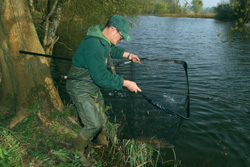 |
| Action… Simon is well-prepared to care for the carp on the bank so no harm will come to it |
Hook link swivels and beads should always be tied so they can EASILY come off lead core leaders. You might think your rig can easily come off your lead core, but can it really? Think about it.
All I’ll say on the issue, in addition to this, that whenever I have netted a fishery (and it’s part of my job to do that), the only tethered fish I have ever found have been attached to lead core because the hook links would not come off that lead core.
If you are going to use it, use it carefully. If you’re not happy with it, there are alternatives. Try pinching blobs of putty along your main line above your rig to achieve the same affect. Or you could try ESP’s excellent Anchor Rig Tubing, which is safe and is also heavier than lead core.
TC: Okay, that about covers lead core! I know you also have some interesting views on some of the antiseptic fluids you can buy. Are they worth using?
SS: I do have some questions in my mind as to how effective healing remedies are in carp fishing. As a species, the carp is very hardy and has a strong ability to heal itself.
I have witnessed carp damaging themselves severely while spawning, yet wounds opened up in the throes of mating heal up very quickly in the lake without any tampering from humans at all. So, where carp are caught just once or twice a year I don’t think you need to treat them with antiseptic fluid.
However, I concede that they may help on pressured waters where individual fish might get hooked several times in a year – but only if the remedy is applied correctly.
Only place a few small drops on the hook mark. Never, and I mean never, cover the carp’s mouth with the stuff. Remember that a carp has an extremely sensitive sense of taste and smell and uses its barbules to detect its food.
If you coat its mouth, eyes and flanks in antiseptic remedy you could be compromising the fish’s ability to detect food for a given amount of time. I once witnessed a young angler spray the whole head of a carp with an antiseptic spray. That probably did more harm than good.
TC: Finally, the sacking of carp. Do you sack the carp you catch? If so, what guidelines do you recommend?
SS: Yes, I do sack carp occasionally, but only for short periods of time and only with the right equipment, at the right time and in the right place. Here are the guidelines you should follow if you need to sack a carp.
Firstly, always use the highest quality sack you can find. Use a sack that is made from material that allows a high degree of water movement through it. To test whether you have found such a sack, go for a quick sprint. When you are out of breath, place your sack over your mouth and breath through it. If you can breath normally, you have a good quality sack. If you struggle for breath, so might a sacked carp – so ditch your sack!
Secondly, ensure your sack has strong retaining cords. Tie knots carefully. Each year anglers forget to do this and carp swim off into the lake inside their sacks because retaining cords are not strong enough. Retaining cords should be several metres long, not a couple of feet.
Thirdly, never sack fish in shallow water. Always sack them in at least four or five feet. This will allow the fish to regulate its position in the water column and find a comfortable depth at which to sit.
Fourth, never sack a fish in direct sunlight. Warm water has less oxygen in it and a fish in such a position will be put in danger. Likewise, never sack a fish at night in weed – after dark weed eats up oxygen, again depriving the fish.
Fifth, always sack a fish for the shortest possible time. A carp should not be left in a sack for longer than two hours, three at the most: any longer than that is simply not acceptable. That time should be more than enough to ensure you get your camera sorted out.
Finally, always sack your carp well away from snags and sharp, underwater objects.
TC: Good advice that all TC readers should take note of. Do you have a final word on the subject of carp safety?
SS: Yes! Make sure you treat all the carp you catch with the utmost respect. If you’re after big fish and catch a 5lb common, treat it in the same way as you would a 35lb common.
Also, treat other species with respect, too: bream and tench, no matter how frustrating their capture may have been, deserve your respect, too.
Top Tips That’ll Help You Care For Your Catch
If your unhooking mat isn’t wet, secure the carp (still in the net) in the margins and wet your mat thoroughly.
When you lift the carp out of the water, ensure its weight is evenly spread.
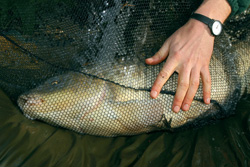 |
| Tuck the fins in so they are flush with the carp’s flank. |
Place the carp in the middle of the mat. To weigh it, gently place it in a WET sling, ensuring the fins are in the correct position.
 |
| If you want a picture of your fish, before you hold it take off any watches or jewellery that could damage the carp if it flaps. |
When transporting the fish from net to mat, always beware of where your lead is. Make sure it doesn’t pull on the hook hold.
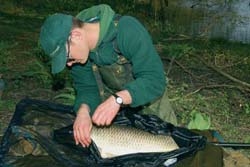 |
| To calm a fish down,, place a wet sack over its eyes. Once the trophy shot has been taken, carry the carp back to the water in a sling. Never carry it in your bare hands! |
On a solid hook-hold, it’s best to use a pair of forceps to unhook your carp. This ensures no lasting damage is done.


